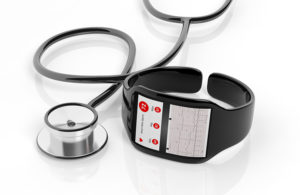Here are three significant trends shaping the Internet of Medical Things (IoMT) space.
Christopher Montalbano, MIDI Medical Product Development

Smartwatch with cardio app on screen and stethoscope, isolated on white background.
Home healthcare is an industry that has seen rapid growth in the past decade, with consumers taking more interest now than ever in understanding, maintaining, and improving their health and wellbeing. As a result, there’s an outpouring of demand for telemedicine and telediagnostic solutions that are simpler, faster and internet-enabled. Internet of Medical Things (IoMT) technology has opened endless opportunities for serving these needs.
Wearable IoMT biosensing lifestyle devices allow the collection of critical biometric in real-time, even outside medical facilities. Networked with smartphone and cloud-based apps, physiological and bio-sensing smart devices continuously measure and record essential metrics and contextual information, which are made easily accessible to users and medical providers.
The devices have proven to be of great value, and their prevalence continues to grow, with many developers now looking to commercialize wearables of their own. Yet, due to their unique components and related intricacies, creating wearables may prove more complicated than with your average medical product. Achieving success requires a clear understanding of these devices, their intended uses, and the processes necessary to make them both safe and maximally beneficial.
Here are three important trends in the space:
1. COVID-19 monitoring using wearables
The COVID-19 pandemic created a huge need for digital health infrastructure, especially for remote patient monitoring. Don’t expect healthcare to return to its pre-COVID way of doing things, either. Predictive analytics paired with wearables can offer early warnings of potential disease. In the case of COVID-19, there’s even the potential to collect anonymous health data across a population and pair it with people’s general location to help public health officials better track the virus’ spread. Wearable IoMT tech can potentially spot the virus early and help people recover.
2. Bioelectronic medicine using wearables
The growing field of bioelectronic medicine has demonstrated that the human body is a biocircuit. Neuromodulation via electrical stimulus in appropriate locations in the body can induce a prescribed reaction to achieve a clinical outcome. When applicable, a “closed-loop” system that automatically adapts to a patient’s clinical state can enhance the efficacy of a therapy. A wearable with EEG can enable real-time observation of how the brain reacts, refining the stimulation through an algorithm.
3. Wearable bio-sensing vs. physiological sensing
Wearable biosensory devices offer providers the opportunity to receive and monitor lab-quality data at any time, making possible higher quality and more personalized healthcare. This ability can be instrumental in preventing needless worsening of conditions when patients require around-the-clock care, reducing waiting periods between when symptoms appear and when a patient may see their provider.
Wearable physiological sensor devices differ from biosensory devices in that they do not utilize a biological body sample but instead continuously measure the user’s physiological parameters through non-invasive body sensors. (Think EEG, EKG, pulse oximetry, skin conductance, blood pressure, heart rate, body temperature, etc.), with non-invasive body sensors that collect vital signs continuously. This category of devices, like biosensory devices, can provide for disease monitoring, prevention and treatment.
Importantly, it’s also possible to combine biosensor technology with physiological technology to produce a robust dataset that offers a more comprehensive picture of the patient’s condition.
Heading toward commercialization
With such initial concerns addressed, moving into development itself is a question of understanding and selecting the parts that will provide a device with its desired capabilities. In the case of wearable devices, the chosen sensor technology will heavily influence eventual functionality. Developers must determine whether the data provided by a device will be most helpful to providers if delivered short-term (daily/weekly), mid-term (monthly/quarterly), or long-term (yearly/lifetime).
In short-term delivery, physiological sensors are most often used, acquiring data in real-time, continuously, and non-intrusively. Meanwhile, mid-term applications typically employ biosensors, which collect data periodically to detect biomarkers in biological body samples. Some devices do so with minimally invasive techniques, while others are entirely non-invasive. In these cases, discrete periodic measurement of data is the preferred mode.
It’s important to deploy a strategic device development approach under ISO-13485 to integrate and harmonize lifestyle, IoMT, biosensing and physiological sensing.
There must be a value proposition between the device offering (paired to cloud services) and the external stakeholders such as doctors, patients, purchasing decision makers, insurance reimbursement and much more. If you’re exchanging value both ways, prepare for a successful journey.
Christopher Montalbano is co-founder and CEO of MIDI Medical Product Development. For over 30 years, he co-pioneered the firm’s DevelopmentDNA quality process and methodology. Montalbano has implemented a comprehensive philosophy involving the fusion of reliable engineering tied to industrial design, cost effective manufacturing design and advanced HMI — utilizing the disciplines in harmonious concert.
The opinions expressed in this blog post are the author’s only and do not necessarily reflect those of MedicalDesignandOutsourcing.com or its employees.